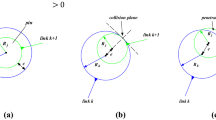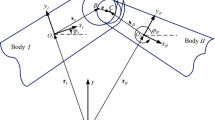Abstract
In this work a new approach to deal with non-ideal operative aspects of spatial revolute joints by means of a three-dimensional finite element analysis (3D-FEA) is presented. The developed model incorporates the inertia of the joint components and the corresponding material properties. The fact that actual joint mechanical components present dimensional and geometrical deviations resulting from the assembly process and operative conditions lead to frequent modifications relative to the design conditions that are worth analyzing. Such nonconformities include manufacturing tolerances and assembly errors, thermal effects, local deformations and clearances that directly affect the behavior and reliability of a mechanism, as they are typically at the origin of vibrations, noise and wear. In this work, a comprehensive assessment of the current contact force models implemented in the MultiBody Dynamics (MBD) approach is performed with the aim of understanding its main flaws and weaknesses, validating the need of a new model that is able to evaluate with accuracy the contact forces obtained. Finally, a benchmark problem is presented through a 3D slider–crank mechanism, allowing for the recognition of the differences that exist when the problem is analyzed by means of the MBD and FEM formulations. For this purpose, one of the joints is modeled as non-ideal, with both radial and axial clearances, the ultimate goal of which is to combine both approaches and, thus establish a crucial and pioneering connection to solve the contact problem.

















Similar content being viewed by others
References
Abdallah, M.A.B., Khemili, I., Aifaoui, N.: Numerical investigation of a flexible slider–crank mechanism with multijoints with clearance. Multibody Syst. Dyn. 38(2), 173–199 (2016)
Yaqubi, S., Dardel, M., Daniali, H.M., Ghasemi, M.H.: Modeling and control of crank–slider mechanism with multiple clearance joints. Multibody Syst. Dyn. 36(2), 143–167 (2016)
Zhang, X., Zhang, X.: Minimizing the influence of revolute joint clearance using the planar redundantly actuated mechanism. Robot. Comput.-Integr. Manuf. 46, 104–113 (2017)
Skrinjar, L., Slavič, J., Boltežar, M.: A validated model for a pin-slot clearance joint. Nonlinear Dyn. 88(1), 131–143 (2017)
Li, J., Huang, H., Yan, S., Yang, Y.: Kinematic accuracy and dynamic performance of a simple planar space deployable mechanism with joint clearance considering parameter uncertainty. Acta Astronaut. 136, 34–45 (2017)
Akhadkar, N., Acary, V., Brogliato, B.: Analysis of collocated feedback controllers for four-bar planar mechanisms with joint clearances. Multibody Syst. Dyn. 38(2), 101–136 (2016)
Cammarata, A.: A novel method to determine position and orientation errors in clearance-affected overconstrained mechanisms. Mech. Mach. Theory 118, 247–264 (2017)
Tian, Q., Lou, J., Mikkola, A.: A new elastohydrodynamic lubricated spherical joint model for rigid-flexible multibody dynamics. Mech. Mach. Theory 107, 210–228 (2017)
Akhadkar, N., Acary, V., Brogliato, B.: Multibody systems with 3D revolute joints with clearances: an industrial case study with an experimental validation. Multibody Syst. Dyn. 2, 1–34 (2017)
Marques, F., Isaac, F., Dourado, N., Souto, A.P., Flores, P., Lankarani, H.M.: A study on the dynamics of spatial mechanisms with frictional spherical clearance joints. J. Comput. Nonlinear Dyn. 12(5), 051013 (2017)
Pereira, C., Ambrósio, J., Ramalho, A.: Dynamics of chain drives using a generalized revolute clearance joint formulation. Mech. Mach. Theory 92, 64–85 (2015)
Costa, J., Peixoto, J., Moreira, P., Souto, A.P., Flores, P., Lankarani, H.M.: Influence of the hip joint modeling approaches on the kinematics of human gait. J. Tribol. 98(3), 031201 (2016). 10 pages
Wang, G., Qi, A., Wang, J.: A differential approach for modeling revolute clearance joints in planar rigid multibody systems. Multibody Syst. Dyn. 39(4), 311–335 (2017)
Marques, F., Isaac, F., Dourado, N., Flores, P.: An enhanced formulation to model spatial revolute joints with radial and axial clearances. Mech. Mach. Theory 116, 123–144 (2017)
Pereira, C.M., Ramalho, A.L., Ambrósio, J.A.: A critical overview of internal and external cylinder contact force models. Nonlinear Dyn. 63(4), 681–697 (2011)
Marques, F., Flores, P., Claro, J.C.P., Lankarani, H.M.: A survey and comparison of several friction force models for dynamic analysis of multibody mechanical systems. Nonlinear Dyn. 86(3), 1407–1443 (2016)
Isaac, F., Marques, F., Dourado, N., Flores, P.: Recent developments on cylindrical contact force models with realistic properties In: New Trends in Mechanism and Machine Science. The Series Mechanisms and Machine Science, vol. 43. Springer, Berlin (2017)
Lankarani, H.M., Nikravesh, P.E.: A contact force model with hysteresis damping for impact analysis of multibody systems. J. Mech. Des. 112, 369–376 (1990)
Earles, S.W.E., Wu, C.L.S.: Motion analysis of a rigid link mechanism with clearance at a bearing using Lagrangian mechanics and digital computation. J. Mech., 83–89 (1973)
Dubowsky, S.: On predicting the dynamic effects of clearances in planar mechanisms. J. Eng. Ind. 96, 317–323 (1974)
Dubowsky, S., Norris, M., Aloni, E., Tamir, A.: An analytical and experimental study of the prediction of impacts in planar mechanical systems with clearances. J. Mech. Transm. Autom. Des. 106, 444–451 (1984)
Veluswami, M.A., Crossley, F.R.E., Horvay, G.: Multiple impacts of a ball between two plates—part 2: mathematical modeling. J. Eng. Ind. 97(3), 828–835 (1975)
Gummer, A., Sauer, B.: Influence of contact geometry on local friction energy and stiffness of revolute joints. J. Tribol. 134(2), 021402 (2012)
Johnson, K.L.: Contact Mechanics. Cambridge University Press, Cambridge (1985)
Pereira, C., Ramalho, A., Ambrosio, J.: Applicability domain of internal cylindrical contact force models. Mech. Mach. Theory 78, 141–157 (2014)
Pereira, C.M., Ramalho, A.L., Ambrósio, J.A.: An enhanced cylindrical contact force model. Multibody Syst. Dyn. 35(3), 277–298 (2015)
Akhadkar, N., Acary, V., Brogliato, B.: Multibody systems with 3D revolute joints with clearances: an industrial case study with an experimental validation. Multibody Syst. Dyn. 42(3), 249–282 (2018)
Ambrósio, J., Pombo, J.: A unified formulation for mechanical joints with and without clearances/bushings and/or stops in the framework of multibody systems. Multibody Syst. Dyn. 42(3), 317–345 (2018)
Isaac, F.: Development of advanced models of spatial mechanical joints with realistic properties. MSc Dissertation, University of Minho, Guimarães, Portugal (2016)
Dassault Systèmes, Simulia Academic, 2016. Abaqus License Software. Providence, RI, USA
Hilber, H.M., Hughes, T.J.R., Taylor, R.L.: Improved numerical dissipation for time integration algorithms in structural dynamics. Earthq. Eng. Struct. Dyn. 5, 283–292 (1977)
Kopp, R., Dohmen, P.M.: Simulation und Planung von Walz Prozessen mit Hilfe der FEM. Stahl U. Eisen 7, 131–136 (1990)
Dormand, J.R., Prince, P.J.: A family of embedded Runge–Kutta formulae. J. Comput. Appl. Math. 6, 19–26 (1980)
Shampine, L.F., Reichelt, M.W.: The MATLAB ODE suite. SIAM J. Sci. Comput. 18, 1–22 (1997)
Johnson, K.L.: One hundred years of Hertz contact. Proc. Inst. Mech. Eng. 196, 363–378 (1982)
Lankarani, H.M., Nikravesh, P.E.: Continuous contact force models for impact analysis in multibody systems. Nonlinear Dyn. 5, 193–207 (1994)
Coulomb, C.A.: Théorie des machines simples, en ayant égard au frottement de leurs parties, et à la roideur des cordages. Mémoire de Mathématique et de Physique. Bachelier, Paris (1785)
Acknowledgements
The first and second authors express their gratitude to the Portuguese Foundation for Science and Technology through the PhD grants (PD/BD/128385/2017 and PD/BD/114154/2016). This work is supported by FCT with the reference project UID/EEA/04436/2013, COMPETE 2020 with the code POCI-01-0145-FEDER-006941. Finally, the authors are much indebted to the anonymous reviewers for useful comments, recommendations and suggestions.
Author information
Authors and Affiliations
Corresponding author
Additional information
Publisher’s Note
Springer Nature remains neutral with regard to jurisdictional claims in published maps and institutional affiliations.
Rights and permissions
About this article
Cite this article
Isaac, F., Marques, F., Dourado, N. et al. A finite element model of a 3D dry revolute joint incorporated in a multibody dynamic analysis. Multibody Syst Dyn 45, 293–313 (2019). https://doi.org/10.1007/s11044-018-09659-9
Received:
Accepted:
Published:
Issue Date:
DOI: https://doi.org/10.1007/s11044-018-09659-9




